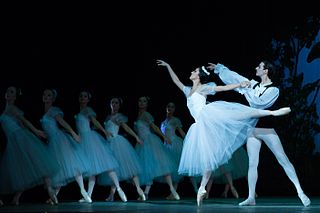
Ballerina skirt is a full skirt that reaches to mid-calf or just above the ankles, worn as a costume in a ballet performance. It is often made up of multiple layers of fabric. It was a popular casual skirt style during the 1950s.

Tamara Platonovna Karsavina was a Russian prima ballerina, renowned for her beauty, who was a principal artist of the Imperial Russian Ballet and later of the Ballets Russes of Serge Diaghilev. After settling in Britain at Hampstead in London, she began teaching ballet professionally and became recognised as one of the founders of modern British ballet. She assisted in the establishment of The Royal Ballet and was a founder member of the Royal Academy of Dance, which is now the world's largest dance-teaching organisation.

Mathilda-Marie Feliksovna Kschessinskaya was a Russian ballerina from a family of Polish origin. Her father Feliks Krzesiński and her brother both danced in St. Petersburg. She was a mistress of the future Tsar Nicholas II of Russia prior to his marriage, and later the wife of his cousin Grand Duke Andrei Vladimirovich of Russia.

Pavel Andreyevich Gerdt, also known as Paul Gerdt, was the Premier Danseur Noble of the Imperial Ballet, the Bolshoi Kamenny Theatre, and the Mariinsky Theatre for 56 years, making his debut in 1860, and retiring in 1916. His daughter Elisaveta Gerdt was also a prominent ballerina and teacher.

Enrico Cecchetti was an Italian ballet dancer, mime, and founder of the Cecchetti method. The son of two dancers from Civitanova Marche, he was born in the costuming room of the Teatro Tordinona in Rome. After an illustrious career as a dancer in Europe, he went to dance for the Imperial Ballet in St. Petersburg, Russia, where he further honed his skills. Cecchetti was praised for his agility and strength in his performances, as well as his technical abilities in dance. By 1888, he was widely accepted as the greatest ballet virtuoso in the world.

The Dying Swan is a solo dance choreographed by Mikhail Fokine to Camille Saint-Saëns's Le Cygne from Le Carnaval des animaux as a pièce d'occasion for the ballerina Anna Pavlova, who performed it about 4,000 times. The short ballet follows the last moments in the life of a swan, and was first presented in St. Petersburg, Russia in 1905. The ballet has since influenced modern interpretations of Odette in Tchaikovsky's Swan Lake and has inspired non-traditional interpretations as well as various adaptations.

Sofia Vasylievna Fedorova was a Russian ballerina.

Emil Vladimirovich Loteanu was a Soviet film director born in Romania. He moved to Moscow in his early life. His best known films are Lăutarii, Gypsies Are Found Near Heaven, A Hunting Accident and Anna Pavlova.
Women's vault competition at the 2008 Summer Olympics was held on August 17 at the Beijing National Indoor Stadium.

Yekaterina Ottovna Vazem was a Russian prima ballerina and instructor, whose most noted pupil was the legendary Anna Pavlova.
Pavlov and its feminine form Pavlova are common Russian and Bulgarian surnames. Their Ukrainian variant is Pavliv. All stem from Christian name Paul. These names may refer to many people:
Yulia Andreyevna Inshina is an artistic gymnast for Azerbaijan. She has been known for her consistent and reliable work especially on beam. Originally a competitor for Russia, she began to represent Azerbaijan in November 2013.
The following lists events that happened during 1931 in the Union of Soviet Socialist Republics.
Yana Vladimirovna Pavlova is a Russian individual and synchronised trampoline gymnast, representing her nation at international competitions.
Cleo Nordi, was a Russo-Finnish ballerina who danced as a soloist with Anna Pavlova's company before becoming a renowned teacher of the Russian ballet tradition in London. She was involved in three dance-related films.
This page is based on this
Wikipedia article Text is available under the
CC BY-SA 4.0 license; additional terms may apply.
Images, videos and audio are available under their respective licenses.









